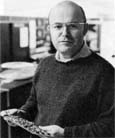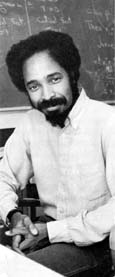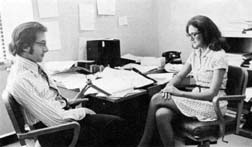PROGRAMMING
LANGUAGE SEMANTICS
& COMPUTER ARCHITECTURE
 Professor Jack B. Dennis
(right) discusses research
problems with graduate
students David Misunas
(left) and Clement Leung.
Professor Dennis, who
heads the Computation
Structures Group, is interested in computer systems
architecture, semantic foundations for computer programs, and modularity in
software and hardware.
Professor Jack B. Dennis
(right) discusses research
problems with graduate
students David Misunas
(left) and Clement Leung.
Professor Dennis, who
heads the Computation
Structures Group, is interested in computer systems
architecture, semantic foundations for computer programs, and modularity in
software and hardware.
The Computation
Structures Group searches
for novel structures and
associated theories in order
to exploit parallelism and
asynchronous computation
in the hardware domain; to
provide a sound semantic
foundation for the software
side; and to insure efficient
deadlock-free operation of
the aggregate. Promising
applications of this research
include the efficient utilization of the increasingly
available, inexpensive
microprocessors with a
reduced programming
effort.
 Professor Jonathan Allen,
who is an affiliate member
of the Laboratory, is interested in computer architecture and natural language
processing. Professor Allen
is also responsible for the
academic undergraduate
program in Computer
Science and Engineering.
Professor Jonathan Allen,
who is an affiliate member
of the Laboratory, is interested in computer architecture and natural language
processing. Professor Allen
is also responsible for the
academic undergraduate
program in Computer
Science and Engineering.

Professor Clarence (Skip) A.
Ellis' research interests are
in parallelism in computer
systems, proofs of program
correctness, and in both the
theoretical and practical
aspects of operating
systems.
 Professor Barbara Liskov and Professor Dennis discuss the
programming language CLU, which is being developed by Professor
Liskov. Besides programming languages, Professor Liskov's research
interests include structured programming, software reliability,
software system design, and operating systems.
Professor Barbara Liskov and Professor Dennis discuss the
programming language CLU, which is being developed by Professor
Liskov. Besides programming languages, Professor Liskov's research
interests include structured programming, software reliability,
software system design, and operating systems.
The programming language CLU is a practical vehicle for study and
development of approaches in structured programming. It provides a
new linguistic mechanism, called a cluster, to support the use of
data abstractions in program construction.
 Professor Carl E. Hewitt is interested in the procedural embedding
of knowledge and the semantics of computation primarily through
the ACTOR message-passing model.
Professor Carl E. Hewitt is interested in the procedural embedding
of knowledge and the semantics of computation primarily through
the ACTOR message-passing model.
PLASMA, an implementation based on the ACTOR model, is being used
to aid in the design and analysis of systems that consist of
cooperating expert problem solving modules. Better semantic
foundations such as ACTORS provide a basis for implementing more
efficient programming methodologies and for gaining deeper insights
into the structure of computation.
 This 1975 MIT Lab for Computer Science
Brochure was reconstructed in HTML by Peter
Szolovits, 1995.
This 1975 MIT Lab for Computer Science
Brochure was reconstructed in HTML by Peter
Szolovits, 1995.
If you have comments, please email them to me.
 Professor Jonathan Allen,
who is an affiliate member
of the Laboratory, is interested in computer architecture and natural language
processing. Professor Allen
is also responsible for the
academic undergraduate
program in Computer
Science and Engineering.
Professor Jonathan Allen,
who is an affiliate member
of the Laboratory, is interested in computer architecture and natural language
processing. Professor Allen
is also responsible for the
academic undergraduate
program in Computer
Science and Engineering. Professor Jack B. Dennis
(right) discusses research
problems with graduate
students David Misunas
(left) and Clement Leung.
Professor Dennis, who
heads the Computation
Structures Group, is interested in computer systems
architecture, semantic foundations for computer programs, and modularity in
software and hardware.
Professor Jack B. Dennis
(right) discusses research
problems with graduate
students David Misunas
(left) and Clement Leung.
Professor Dennis, who
heads the Computation
Structures Group, is interested in computer systems
architecture, semantic foundations for computer programs, and modularity in
software and hardware.
 Professor Barbara Liskov and Professor Dennis discuss the
programming language CLU, which is being developed by Professor
Liskov. Besides programming languages, Professor Liskov's research
interests include structured programming, software reliability,
software system design, and operating systems.
Professor Barbara Liskov and Professor Dennis discuss the
programming language CLU, which is being developed by Professor
Liskov. Besides programming languages, Professor Liskov's research
interests include structured programming, software reliability,
software system design, and operating systems. Professor Carl E. Hewitt is interested in the procedural embedding
of knowledge and the semantics of computation primarily through
the ACTOR message-passing model.
Professor Carl E. Hewitt is interested in the procedural embedding
of knowledge and the semantics of computation primarily through
the ACTOR message-passing model. This 1975 MIT Lab for Computer Science
Brochure was reconstructed in HTML by Peter
Szolovits, 1995.
This 1975 MIT Lab for Computer Science
Brochure was reconstructed in HTML by Peter
Szolovits, 1995.